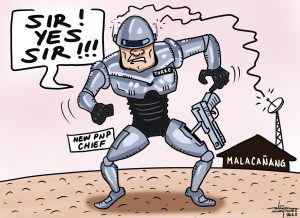Since a month or two ago, work on the Davao-Bukidnon Road, specifically on the stretch fronting the Tugbok Elementary school has been ongoing. The way the work is done we can safely assume that the asphalt two lanes on the center of the four-lane highway will be replaced with concrete. Motorists using that road, for certain, are happy with such development. We, too, who frequently use the road, are elated as well.
What’s bothering us though, as well as the other motorists, is the way the contractor of the road rehabilitation project is treating safety as a component in its implementation. We do not know though if the said road project is undertaken by the government through the Department of Public Works and Highways (DPWH) or it is done by a contractor.
But whoever is doing the project we find it imperative that they should take a close look at the way they install the warning signs on both approaches to where the work is ongoing.
Yes, there are warning signs installed advising that the center lanes are undergoing excavation. But what are installed are not the standard warning signs. Instead these are a caboodle of worn-out plywood where the warning notice is inscribed, decrepit sacks and other materials being hung.
Worst, the paint used in inscribing the warning message is not even the reflectorized kind to make it highly visible during night time, especially when it is raining.
We do not know how much the project contractor, or the DPWH for that matter consider safety as a core value in their work ethics. But if they think of safety as an important component in delivering quality work output, then either the contractor or the DPWH should exert effort to install better and acceptable warning signs. And this has to be done before any vehicular accident happens in that part of the Davao-Bukidnon Road.
What about some inspection visits on the project site friend Dean Ortiz?
And talking of makeshift warning signs on road projects we are again brining this out. These road warning signs are also prevalent at the ongoing expansion project of the Catalunan Grande barangay road.
All the warning signs including those giving motorists direction, as well as those installed on the still to-be-transferred electric poles are done in ordinary paint, not the reflectorized one. So these are hardly visible during the night, more so those installed on stretches where there are hardly functioning street lights.
And as we have earlier disclosed in this space before, because of these poorly done warning signs on the Catalunan Grande road expansion project we had a near accident courtesy also of a drunken motorcycle driver. He was crisscrossing the entire width of the road towards our direction. When we tried to evade the incoming motorbike we nearly hit the concrete electric pole that has no light on it even as we hardly saw the ordinary red paint warning around the post.
Again, in behalf of other motorists who do not have the venue to air their complaints on this seeming disregard of safety we are calling the attention of the DPWH. All the agency needs to do is conduct an inspection. If possible do it during night time. We believe it is not too much of a request from the citizens who pay taxes to help see through infrastructure projects like road rehabilitation and expansion.
**************************
The dream of having the Island Garden City of Samal connected to the Davao mainland through a bridge was hatched since several decades ago. It has been promised by several Davao politicians. Its realization though seems to have come to certainty when former Davao City Mayor Rodrigo R. Duterte won the Presidency during the May 2016 election.
With his assumption to office there was some kind of frenzy in preparing the groundwork for the implementation of the multi-billion peso span. The latest was the conduct of a feasibility study funded by the Japan International Cooperation Agency (JICA).
Last week however, we read reports in local dailies that say the construction of a bridge appears to be not feasible. Instead, an underwater tunnel is being looked into as possible alternative to link the island city with the Davao mainland.
From where we are perched we see this project as even much costly than a bridge. And if reports are true that one criterion usually required by government economic development planners in approving big-ticket infrastructure projects is that it can assure a 10 percent return on investment (ROI), then a tunnel link is much less likely to get approved.
In fact, even the long-dreamed of Davao-Samal bridge is not likely to meet the ROI requirement given the present level of economic activities in the island city. Therefore, the link Davao-Samal project may again be passed on to another administration still a dream.
Of course, to dream is free. So it’s better to dream big.
Rough Cuts: Those dangerous road warning signs
More from OPINIONMore posts in OPINION »

